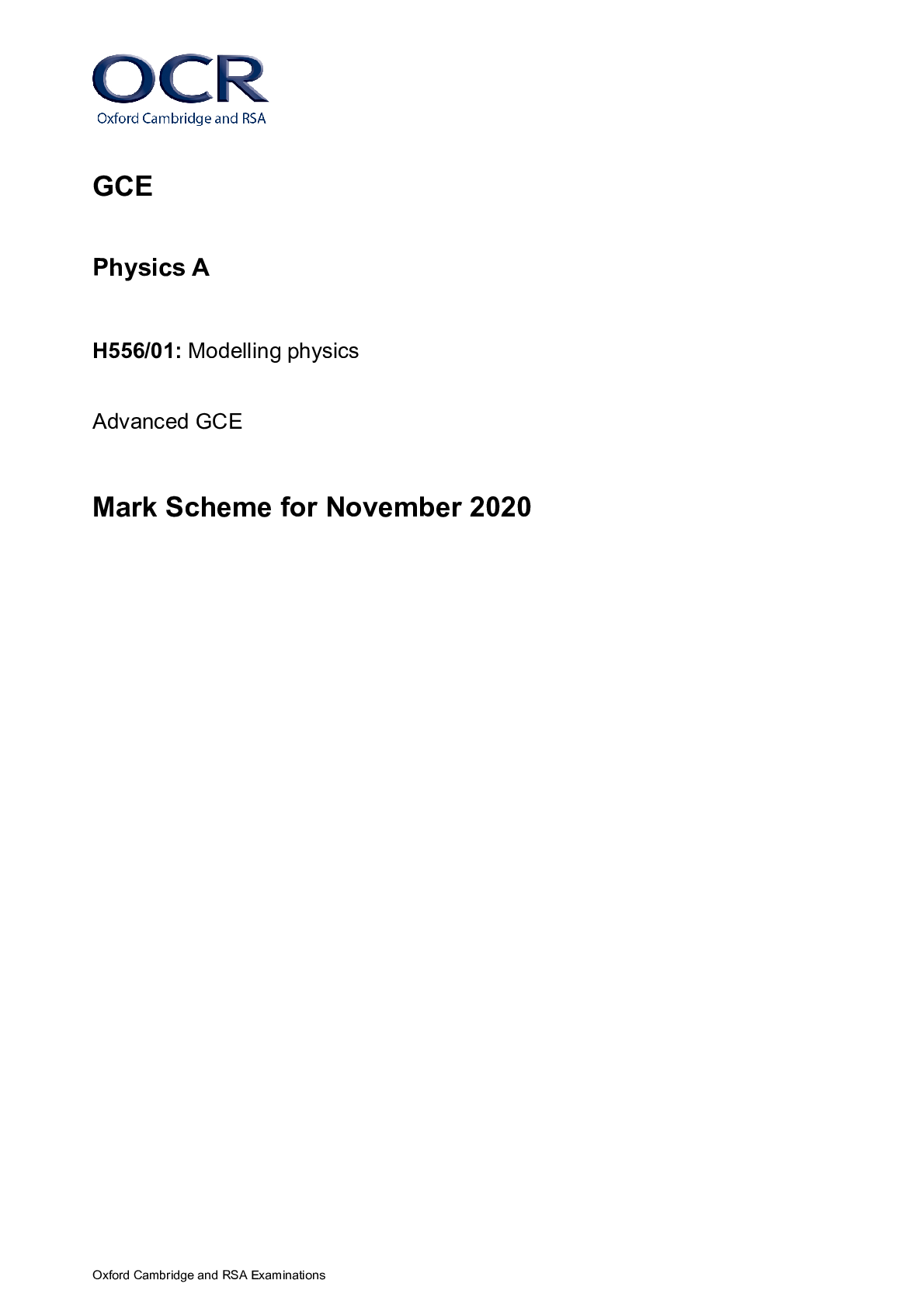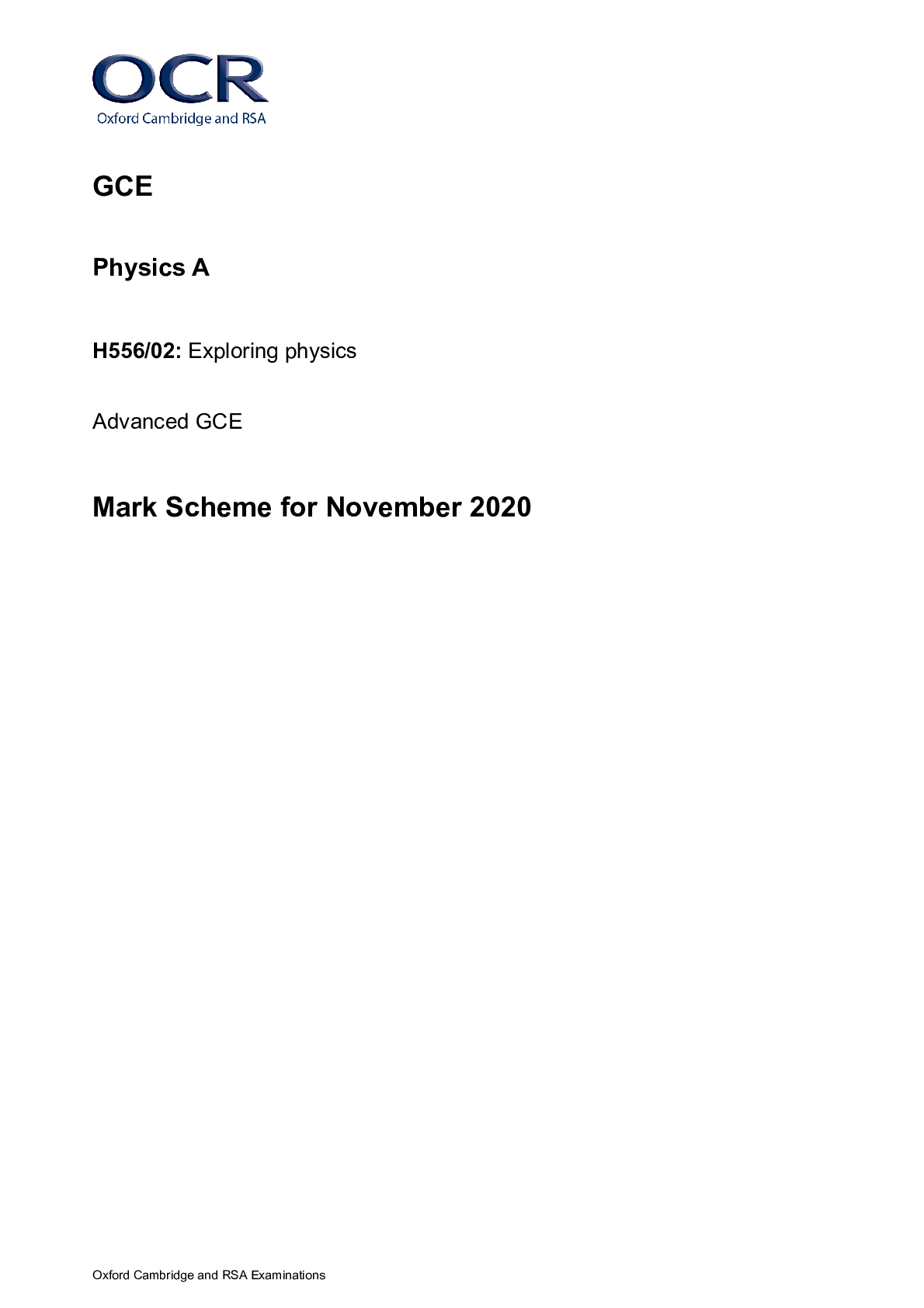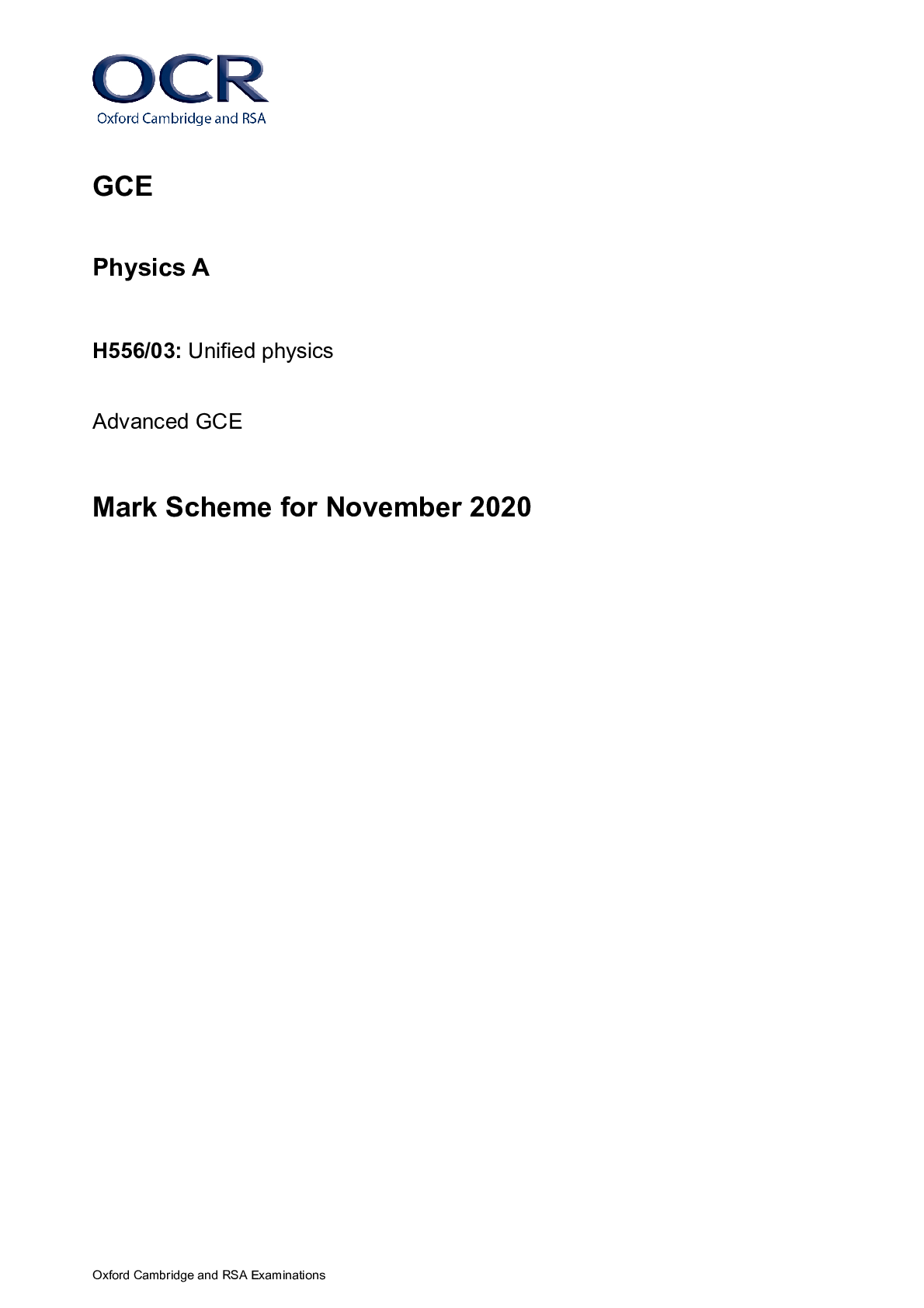English Language > AS Mark Scheme > GCE English Language H470/02: Dimensions of linguistic variation Advanced GCE Mark Scheme for Autumn (All)
GCE English Language H470/02: Dimensions of linguistic variation Advanced GCE Mark Scheme for Autumn 2021
Document Content and Description Below
Oxford Cambridge and RSA Examinations GCE English Language H470/02: Dimensions of linguistic variation Advanced GCE Mark Scheme for Autumn 2021Oxford Cambridge and RSA Examinations OCR (Oxford C... ambridge and RSA) is a leading UK awarding body, providing a wide range of qualifications to meet the needs of candidates of all ages and abilities. OCR qualifications include AS/A Levels, Diplomas, GCSEs, Cambridge Nationals, Cambridge Technicals, Functional Skills, Key Skills, Entry Level qualifications, NVQs and vocational qualifications in areas such as IT, business, languages, teaching/training, administration and secretarial skills. It is also responsible for developing new specifications to meet national requirements and the needs of students and teachers. OCR is a not-for-profit organisation; any surplus made is invested back into the establishment to help towards the development of qualifications and support, which keep pace with the changing needs of today’s society. This mark scheme is published as an aid to teachers and students, to indicate the requirements of the examination. It shows the basis on which marks were awarded by examiners. It does not indicate the details of the discussions which took place at an examiners’ meeting before marking commenced. All examiners are instructed that alternative correct answers and unexpected approaches in candidates’ scripts must be given marks that fairly reflect the relevant knowledge and skills demonstrated. Mark schemes should be read in conjunction with the published question papers and the report on the examination. © OCR 2021H470/02 Mark Scheme October 2021 AnnotationsH470/02 Mark Scheme October 2021 PAPER-SPECIFIC INSTRUCTIONS: H470/02 Dimensions of linguistic variation Candidates answer all the questions on the paper. The paper addresses assessment objectives 1-4: Assessment Objectives AO1 and AO2 are addressed in question 1. Assessment Objectives AO2 and AO3 are addressed in question 2. Assessment Objectives AO1, AO3 and AO4 are addressed in question 3. AO5 is assessed in components 1 and 3. In each question, the assessment objectives are given equal weighting. THE INDICATIVE CONTENT FOR EACH TASK provides an indication of what candidates are likely to cover. The notes are neither prescriptive nor exhaustive: candidates should be rewarded for any relevant response which appropriately addresses the Assessment Objectives. THE LEVEL DESCRIPTORS FOR EACH QUESTION FOLLOW THE INDICATIVE CONTENT SUBJECT-SPECIFIC INSTRUCTIONS: ENGLISH LANGUAGE • Each level descriptor covers the relevant assessment objectives. • Where the assessment objectives appear in separate columns, marks should be allocated for each assessment objective independently of one another. There is no requirement for responses to be allocated marks from within the same level across each assessment objective. • An answer does not have to meet all the requirements of a level descriptor before being placed in that level. The extent to which it meets all of the requirements of a level descriptor will determine its placement within that level. • The extent to which the statements within the level have been achieved should be the only criteria used when deciding the mark within a level. • Indicative content indicates possible points candidates might make, but this is not an exhaustive account. Any valid response should be rewarded.H470/02 Mark Scheme October 2021 Indicative Content - Please note: indicative content indicates possible points candidates might make, but this is not an exhaustive account. Any valid response should be rewarded. Question Guidance Marks Text features 1 Text A is a transcript from a private data source featuring a sister and brother, Natasha and Charlie. Natasha is three and ten months; Charlie is one and eleven months. One of their mothers, Danielle, is also present. Both children are wearing frog masks they have made, and they are filming a message to send to Rosie, their other mother. Using the appropriate terminology to explain your findings, examine the language development stage of the child-participants as evidenced in the transcript. You should identify and analyse the phonology, grammar and meaning of their utterances. Use your knowledge of theories and concepts of child language acquisition to support your answer. Meaning: • Beth uses labelling correctly ‘froggie’, albeit in a diminutive form. • Natasha responds to Danielle’s suggestions and builds on them. Charlie copies her. • Both children seem to enjoy playing with language and sound within the context of sending a message while wearing frog masks. • Element of performance. 20 Phonology: • There is gliding/substitution from Charlie ‘/fwɒg/’. • Rhyming and repetition of ‘frog’ with a range of words/sounds throughout, initiated by Natasha and copied by Charlie, suggests playful experimentation with sound. • Natasha uses largely standard pronunciation, more so than Charlie, except for the playful elements of her speech. • Most utterances are from Natasha; Charlie follows her lead and copies several of them. Grammar: • Natasha uses subject and object pronouns correctly ‘do you miss me’; Charlie copies her. • Syntactic parallelism used by Natasha first person pronoun + verb, e.g. ‘I like froggie’. • All of the children’s utterances are in the present tense. • Some use of concrete nouns – ‘froggie’, ‘logger’ [log], – reflecting topic/activity. • Natasha sometimes omits auxiliary verbs ‘I little froggie cola’, but not always ‘I’m a little froggie’. • Natasha uses standard syntax (e.g. subject-verb-object) appropriately ‘I like going on a loggy’. • Natasha makes use of an interrogative, ‘do you miss me’, and declaratives, ‘I’m a little frog’. • Repeated pre-modifier ‘little’. • Use of ‘froggie’ as an adjective (‘froggie things’) as well as a noun (‘little froggie’).H470/02 Mark Scheme October 2021 Question Guidance Marks Text features 1 • Natasha privileges phonological playfulness over meaning, creating neologisms, for example, such as ‘froggagola’. Concepts: • The mother’s interaction provides scaffolding (Bruner) and positive attention/encouragement as well as modelling of ‘tell her you love her’ (Skinner), which Natasha uses as a grammatical structure for her response ‘I love you mummy frog’. 20 There may be specific relevant comment on the mother’s interventions; these should be rewarded (although the focus needs to remain with the child participant). For example: • The mother uses of imperative and interrogative sentence functions (‘Tell her you love her’, ‘do you want to do a frog dance’) to support the children and provide scaffolding. • The mother supports the children’s shared imaginative leap ‘give mummy Rosie a frog message’. • Many of the utterances include or revolve around objects – frogs/logs/cola – supporting Nelson’s findings that nouns/naming words represent 60% of children’s early word production. • Capacity for imaginative play suggests cognitive development (link to Piaget) and also Halliday – imaginative function of language: ‘I being a little froggagola’. • Some of the speech is interactional (Halliday). • Could mention Vygotsky’s ZPD – Danielle is encouraging the children to extend/adapt their speech to message format ‘give mummy Rosie a frog message’.H470/02 Mark Scheme October 2021 There are a total of 20 marks available for Question 1. Decide on a mark for AO1 out of 10, and then a separate mark for AO2 out of 10. Add the two marks together to reach a total out of 20 marks. It is possible that candidates may achieve different bands for each AO: allocate the mark according to the level of competency demonstrated for each AO individually. Level AO1 Mark AO2 Mark 5 • Assured reference to a wide range of language features, with appropriate and well-selected examples which support a focussed analysis. • The response will be enhanced by consistently accurate use of a wide range of appropriate terminology; writing is in a secure academic register. 9–10 • The response will make assured reference to stages of development explained and explored effectively, with well-selected examples. • The response will make discerning/perceptive links to theory or concepts in a way that suggests assured understanding of the relationship between theory and practice. 9–10 4 • The response will make consistently accurate and sustained reference to a range of language features, with appropriate examples and developed analyses. • The response will make consistently accurate use of a range of appropriate terminology to enhance the response; written expression is coherent. 7–8 • The response will make consistently accurate reference to stages of development with appropriate examples and an analysis which demonstrates awareness of the complexity of the processes involved. • The response will consistently connect the elements of the participants’ language usage with a variety of concepts/ theories in a way that suggests secure understanding of the relationship between theory and practice. 7–8 3 • The response will make generally accurate reference to a range of language features, with appropriate examples and a clear attempt at analysis. • Accurate use of appropriate terminology will enhance the response; written expression is clear. 5–6 • The response will make generally accurate reference to stages of development, with appropriate examples and supporting comment or explanation. • The response will connect the elements of the participants’ language usage with concepts and theories in a way that is valid and relevant. 5–6H470/02 Mark Scheme October 2021 Level AO1 Mark AO2 Mark 2 • The response will identify some relevant language features, with appropriate examples and relevant comments. • Appropriate terminology will be used accurately, although the range of terminology will be limited; written expression has some errors but the meaning remains apparent. 3–4 • The response will make some accurate reference/s to stages of development, with some relevant comments or appropriate examples. • The response will make valid connections between elements of the participants’ language usage and concepts or theory. 3–4 1 • The response will identify features of the material, but will make very few relevant or valid points about these features in relation to the question. • Little or no accurate use of appropriate terminology; writing may at times obscure meaning. 1–2 • The response will make little or basic reference to stages of language development. • Few if any valid links between elements of participants’ language and appropriate stage/s of development or other relevant concepts. 1–2 0 • No response or no response worthy of any credit. 0 • No response or no response worthy of any credit. 0H470/02 Mark Scheme October 2021 Indicative Content - Please note: indicative content indicates possible points candidates might make, but this is not an exhaustive account. Any valid response should be rewarded. Question Guidance Marks Text features 2 Text B is an extract from an online article posted on the website of The Guardian newspaper on December 30th 2012. It appeared in the education section. Using your understanding of relevant ideas and concepts, investigate how language features and contextual factors construct meanings in this text. Possibilities are provided below for guidance but any valid response should be rewarded. This online article contains characteristic features of multi-modal texts. It poses questions about the apparent reluctance of female students to pursue physics at GCSE level, A Level, and beyond, and explores possible reasons for this and speculates about attitudes from – and representations of – males as well as females. As well as raising issues about gender, candidates are also likely to link it to power, as it presents the findings of the Institute of Physics, using information provided by the National Pupil Database, as well as several industry experts. There are references to a range of factors which may affect academic choices; within this context, links could be made to influential as well as instrumental power. 24 Possibilities are provided below for guidance but any valid response should be rewarded. • The accompanying image, of seven female students conducting a physics experiment reflects the topic of the written text. Their positive body language suggests that the assumptions underpinning the question posed in the headline may be contradicted and/or the question may be answered in unexpected ways. • By using the interrogative ‘Are sexist attitudes still to blame…’ the writer is aligning herself with an anti-sexist stance. • Goodman – informalisation – could also be mentioned. • Representation of (female) professor as successful in what has traditionally been a male-dominated subject is presumably intended to disarm gender stereotypes (could link to Pilkington). • Could be linked to Cameron – assumptions engendered in world of education – examines the view that females are better suited to subjects such as biology: ‘They say that biology is perceived as more girl-friendly, because it is the gateway to medicine and involves more human interaction’, males drawn to ‘more academically challenging subjects’ like physics. • Graphological features that are characteristic of genre e.g. links to social media. Latinate/relatively sophisticated lexical choices, ‘ingrained cultural perception in coeducational establishments’ reflect broadsheet context. • Lexical fields of science and study ‘heat-resistance experiment’, ‘A-level’, ‘experimental physics’, and ‘coeducational schools’ reflecting topic.H470/02 Mark Scheme October 2021 • Range of proper nouns/names to establish credibility of views being expressed/influential power (Fairclough), particularly that of Athene Donald, a Cambridge professor in the field. • Use of numbers/statistics throughout adds credibility – connotes instrumental power of auditing organisation/process. • Representation of female physics professor through use of the metaphor ‘champion’ suggests context of an ongoing battle that needs to be fought. • Naming of participants and postmodified or noun phrases in apposition (quite long noun phrases too) ‘Alice, a sixthformer at Lampton School in Hounslow, west London’ Pragmatics: • Represents girls as being less likely to study physics than boys, although seemingly confirms clichéd expectations of girls in the opening: ‘You might expect her to be talking about the latest Twilight film or a teenage boy band. But no: Alice is talking about heat resistance’ – writer’s positioning in relation to the expectations expressed is unclear. • The article focuses on asymmetry in subject choices, but the focus is on encouraging female students to move into science rather than encouraging male students to move away from what is described as ‘dull, repetitive experiments on a lab bench and struggling with equations’. • Assumptions are made about shared cultural reference, Twilight, but ‘teenage boy band’ may be deliberately vague – perhaps assuming older readership. • Idiomatic reference to ‘a bit of stick’ may be a euphemistic way of describing resistance to girls studying physics – it disguises the seriousness and extent of the opposition they may face.H470/02 Mark Scheme October 2021 • Uses a relatively high proportion of the students’ own words, also represents Alice, as an example, positively in terms of enthusiasm: ‘her eyes are gleaming. As she speaks, her face grows pink with excitement and her hands wave around expressively’. However, this may be at the expense of competence: ‘The most exciting experiments are when a normal one goes horribly wrong’. • Use of influential power (Fairclough) – reference to successful professor and auditing body. • Use of Lampton School as a specific example of what can be done to address the asymmetry; semantic field of deterioration, ‘risk’, ‘slip’, ‘problem’, suggests the writer’s underlying feeling that this needs to happen.H470/02 Mark Scheme October 2021 There are a total of 24 marks available for Question 2 Decide on a mark for AO2 out of 12, and then a separate mark for AO3 out of 12. Add the two marks together to reach a total out of 24 marks. It is possible that candidates may achieve different bands for each AO: allocate the mark according to the level of competency demonstrated for each AO individually. Level AO2 Mark AO3 Mark 6 • Candidates show an assured knowledge and understanding of relevant concepts and issues. • Candidates engage critically with the ways concepts and issues inform their analysis of the text’s patterns of language use. 11–12 • Candidates offer a discerning exploration of a range of contextual factors and language features, and how they are associated with the construction of meaning. • Candidates evaluate in perceptive detail how contextual features inherent in the text are associated with the construction of meaning. 11–12 5 • Candidates show a good knowledge and understanding of relevant concepts and issues. • Candidates use their knowledge and understanding of concepts and issues to offer informed comment of the text’s patterns of language use. 9–10 • Candidates respond in detail to a range of contextual factors and language features, and how they are associated with the construction of meaning. • Candidates will analyse in detail how contextual features inherent in the text are associated with the construction of meaning. 9–10 4 • Candidates show a sound level of knowledge and understanding of relevant concepts and issues. • Candidates use their knowledge and understanding of concepts and issues to comment on some language features in the text. 7–8 • Candidates make a sound attempt to respond to a range of contextual factors and language features, and how they are associated with the construction of meaning. • Candidates make clear, relevant response to the contextual features inherent in the text and how these are associated with the construction of meaning. 7–8 3 • Candidates show a largely accurate knowledge and understanding of language concepts or issues, although is likely to lack the depth needed to be convincing. • Candidates use their knowledge and understanding of concepts and issues to comment generally on language use in the text. 5–6 • Candidates make some attempts to respond to contextual factors and language features and make some points about how they are associated with the construction of meaning. • Candidates make general comments regarding the contextual features inherent in the text, showing some understanding of how these are associated with the construction of meaning. 5–6H470/02 Mark Scheme October 2021 Level AO2 Mark AO3 Mark 2 • Candidates’ knowledge and understanding of concepts/issues is likely to have inaccuracies or be muddled. • Candidates use concepts/issues to comment on the text, although connections may be lacking or confused. 3–4 • Candidates make a limited response to contextual factors and language features and how they are associated with the construction of meaning. • Candidates show a basic understanding of how contextual features inherent in the text contribute to the overall meaning. 3–4 1 • Candidates select irrelevant or unconnected concepts or issues, or presents erroneous accounts of concepts. • Candidates attempt to use concepts or issues to the text, although these will be superficial. 1–2 • Candidates make only one or at the most two references to contextual factors and language features and how they are associated with the construction of meaning. • Candidates make little attempt to show understanding of how one or more contextual features inherent in the text contribute to the overall meaning. 1–2 0 • No response or no response worthy of any credit. 0 • No response or no response worthy of any credit. 0H470/02 Mark Scheme October 2021 Indicative Content - Please note: indicative content indicates possible points candidates might make, but this is not an exhaustive account. Any valid response should be rewarded. Question Answer Mark Guidance 3 Text C is an extract from a letter published in The Hawaiian Gazette concerning volcanic activity. It appeared in 1868. Text D is an extract from an online article produced by the Hawaii Volcano Observatory. It was published in April 2018. It informs readers about the volcanic eruption in 1868. By detailed analysis of the writing in both passages, discuss and illustrate the variations in language between the 19th and 21st centuries. Answers should explore the ways language is used in each text, as well as how contextual factors influence the way meaning is constructed. AO3: Text C’s general contextual features: The text was part of a letter written to the editor of a local newspaper describing volcanic activity in South Hawaii. The focus is on the impact made on the surroundings, and, in general, it is scientific and precise in its approach, although it also contains reference to individuals and their belongings, and is 36 Lexis and semantics Text C Text D • Nature of document – about volcanic activity and its impact on the surroundings – lends itself to multiple concrete nouns. Most of these would be known to the general reader, e.g. ‘crater’, ‘fissures’ and ‘stream’, and especially well known to local readership. • Usage of ‘rent’ quite archaic; ‘render’ less so but noteworthy. • Formal register: ‘Sir’ letter convention of time, use of ‘hasten’, ‘let me state here at once’. Some Latinate language, ‘convulsions’, ‘descended’, ‘extensive’. • Lexical field of communication linking with purpose of letter: ‘statement’, ‘correspondents’, ‘scene’; ‘communicated’. • Some verb/verb phrase choices with emotive overtones used to represent the damage done by the volcano, ‘rent by’, ‘thrown down’, ‘lost’. • Some scientific language but nothing particularly technical; • Nature of document – about volcanic activity and its impact on the surroundings – lends itself to multiple concrete nouns, ‘mountain, ‘lava’, and so on. ‘There is also specialist lexis décollement’ which was glossed for readers of the original text. • Lexical field of conflict, ‘damage', ‘destroyed’, ‘devastated’, and of volcanoes, ‘volcanic’, ‘lava’, ‘mudslide’; use of ‘struck’ and ‘rival’ almost personifying the eruption. • Use of dramatic lexis/journalese, ‘most deadly’ ‘destruction’ ‘volcanic crisis’ makes for comparison with emotive examples opposite in earlier text. • Use of dates to highlight specific events ‘April 25, 2015’, also numbers, ’16 days’, ‘90,000’. • Frequent references to measurement add credibility/exactitude ‘magnitude- 7.8 Nepal’. • Lexical field of change, ‘moved’, ‘subsided’, ‘shaking’.H470/02 Mark Scheme October 2021 occasionally personal in tone, especially at the start. ‘examined’, ‘mass’, ‘prisms’. • Verbs relating to writer’s own movements and to place, ‘crossed’, ‘reached’, ‘descended’. Grammar and morphology Text C Text D • Clause-laden sentences characteristic of the period and directly comparable with other text. • Relative clauses used to qualify/provide additional information ‘On the west and north-west side, where the fire had been most active…’. • Active sentences mainly foreground the writer’s role ‘I descended’; some passive voice sentences describe what has happened to the surroundings as a result of the volcano, ‘A heavy bookcase in the Rev. T. Coan’s library… was overturned’. (See pragmatics section.) • Largely declarative sentences, mostly complex or complex/compound. • Mixture of tense/aspect to describe different aspects of the • Some complex sentences with embedded clauses, e.g. ‘which also occurred on the décollement’, but less complexity than Text C. • Use of dynamic verbs: ‘bounced’, ‘destroyed’, and idiomatic verb use ‘unlocked’. • Conditional, ‘If it happened today’, to place the earthquake in a temporal context. • Mixture of tense/aspect to describe different aspects of the situation and writer’s reporting of it. • Pre-modifying adjectives ‘ancient ocean floor’, ‘deadly events’ to add precision. • Modal auxiliary ‘Its size would also rival two of the most deadly events’ used to create comparison. • Proper nouns throughout reflecting focus on place, ‘Wood Valley north of Pahala’, ‘Ka’u to Hawaii Island’s northern Hamakua Coast’. • Declarative sentences usedH470/02 Mark Scheme October 2021 situation and writer’s reporting of it. • Prepositions and prepositional phrases to create a precise account of the volcano’s impact ‘around’, ‘parallel to’. • Use of first-person pronoun more evident at start; as the description progresses it becomes more impersonal/ scientific in its approach. • Intensifiers ‘very’, comparatives ‘lesser’ and superlatives ‘most active’ used to facilitate precision. • Syntax in ‘Of Hilo I have little to say’ fronted adverbial quite archaic or at least quaint. • ‘holding that relation to the wave’ quite formal and unwieldy anaphoric reference to previous sentence. throughout. • Repetition of superlatives, ‘strongest’, ‘most deadly’. • Passive voice disguises lack of provenance of information ‘A tsunami… was estimated to be more than 20 feet high in Ka’u’.H470/02 Mark Scheme October 2021 Question Answer Mark Guidance 3 Text D’s general contextual features: Extract of an article from a news website. It has been produced by the Hawaii Volcano Observatory and was published in April 2018. AO4: While both texts focus on volcanic activity and its impact on the local surroundings, the accounts are different, partly in terms of their temporal relationship to the event; the earlier text is relating recent/current events while the second text, although it is a newspaper, is reporting an event that happened over a century before. There is a much stronger sense of the individual writer in Text C; as well as writing in the first person, he refers to specific experiences he has had and where and when they occurred. Text D is more neutral and impersonal. The focus in the first text is on an individual’s observations; the second text takes a more historical view, placing the earthquake in context and comparing it with other subsequent events (clearly these would not be accessible to the writer of Text C). There is no preoccupation with individuals – the emphasis is on groups and on the geological implications. Sentences in Text D are shorter and 36 Discourse Text C Text D • Textual cohesion is provided by the letter format, to some extent – the author establishes introduces his purposes of describing the impact of the volcanic eruption and goes on to do so. • The text is divided into paragraphs detailing the destruction wrought by the volcano, and there is a conventional contemporary address and signing off. • The most explicit engagement with the reader is at the beginning. • Informative style. • Chronological structure underpins the account, leading to use of discourse markers, particularly temporal ones, ‘This week marks 150 years since’, ‘If it happened today’. • Short paragraphs characteristic of online articles. • Ending acts as a mini summary, followed by hook into subsequent article. • Graphological features including headline typical of article genre. • Syntactic parallelism to create listing: ‘The waves caused damage from South Point (Kalae) to Cape Kumukahi (Kapoho), destroyed more than 100 structures, and took 47 lives’. Pragmatics Text C Text D • The description is framed in terms of what is urgent ‘I hasten to give you a statement of what I observed’ and newsworthy ‘Of Hilo I have little to say, as your correspondents have communicated to you the most remarkable events from that • Framing it in relation to other earthquakes provides factual context, ‘the event had the same maximum intensity as the 1906 San Francisco earthquake’. • Presenting it as a potentially entertaining narrative, ‘The April 2 great Ka’u earthquake was part of aH470/02 Mark Scheme October 2021 grammatically less complex, and less of the lexis is Latinate. Possibilities are provided (right) for guidance but any valid response should be rewarded. Each language level is taken in turn to illuminate the likely connections which may be explored by candidates across both texts. place…’. • The use of the active voice emphasises the writer’s industry in exploring and describing the volcanic activity; the use of the passive represents the landscape as being at the mercy of the volcano. • Some emphasis on status in asserting his own role and in referencing the damage done to the property of the local clergyman, presumably an important figure within the community. larger volcanic crisis that unfolded over 16 days’, is a persuasive device presumably made possible by the passage of time. • Use of jargon and subsequent glossing meets text’s informative purpose: ‘known geologically as a décollement’. • Description of the impact on people is present ‘A mudslide in Wood Valley north of Pahala buried 31 Hawaiians’ but the impact on groups is considered, rather than focusing on individuals. • Some possible use of hyperbole ‘deadly’, ‘devastation’, not necessarily unjustified but the way it is framed does suggest usage for sensational effect. • Factual content juxtaposed with figurative language ‘, where people were bounced like balls from shaking’ for increased impact.H470/02 Mark Scheme October 2021 There are a total of 36 marks available for Question 3. Decide on a mark for AO1 out of 12, and then a separate mark for AO3 out of 12, and a separate mark for AO4 out of 12. Add the three marks together to reach a total out of 36 marks. It is possible that candidates may achieve different bands for each AO: allocate the mark according to the level of competency demonstrated for each AO individually. Level AO1 Mark AO3 Mark AO4 Mark 6 • Candidates apply a wide range of appropriate methods in an assured and systematic way, using appropriate terminology and writing in a secure academic register. • They deftly establish and explore patterns of language use and can closely analyse incisively chosen evidence. 11–12 • Candidates make discerning points about the possible effect of contextual factors on particular features of language, both in terms of production and reception. • They perceptively evaluate their points, suggesting alternatives for how context might account for variations in language use. 11–12 • Candidates selectively and methodically apply confident knowledge of appropriate linguistic concepts across both texts. • Candidates compare particular linguistic features in the two texts, making illuminating connections between them which clearly establish some of the ways that language has varied over time. 11–12 5 • Candidates apply a range of appropriate methods to the texts in a systematic way, using appropriate terminology and coherent written expression. • They establish patterns of language use and can analyse well-chosen evidence in some depth. 9–10 • Candidates make strong and helpful points about relevant contextual factors, showing how context might affect language use, both in terms of production and reception. • They show that they can weigh up how contextual factors might account for variations in language use. 9–10 • Candidates methodically apply sound knowledge of appropriate linguistic concepts across both texts. • Candidates compare linguistic features in the two texts, making helpful connections between them which show some of the ways that language has varied over time. 9–10H470/02 Mark Scheme October 2021 Level AO1 Mark AO3 Mark AO4 Mark 4 • Candidates apply some appropriate methods in a sound way, using mostly appropriate terminology and coherent if uneconomical writing. • Analysis is characterised by either a fairly limited number of well-developed points, with relevant evidence, or a larger number of valid supported points that lack depth. 7–8 • Candidates make some valid points about context, showing how contextual factors can affect language production and reception. • They come to some sound conclusions about how contextual factors could cause variations in language. 7–8 • Candidates apply accurate knowledge of linguistic concepts to language features in a way that is mostly appropriate, across both texts. • They make some comparisons of linguistic features in the two texts, making some connections between them which show ways in which language use has varied over time. 7–8 3 • Candidates attempt to apply linguistic methods with some success, and terminology is at times appropriate; written expression contains some errors. • Analysis is uneven and is characterised by either scattered points that are supported with evidence or points which may have validity but are unsupported. 5–6 • Candidates make a few successful attempts at showing how basic contextual factors affect the way language is produced and received. • Conclusions drawn tend to be assertive and simplistic rather than weighed in the balance and are sometimes unconvincing; there may be an elementary sense of how context affects language variation. 5–6 • Candidates have a loose grasp of linguistic concepts and attempt to apply them across both texts, although sometimes unconvincingly. • They will make more general connections and will attempt to compare particular features associated with the ways language use has varied over time, but with only partial success. 5–6H470/02 Mark Scheme October 2021 Level AO1 Mark AO3 Mark AO4 Mark 2 • Candidates make a vague attempt to apply linguistic methods to the texts and some terms are used, with occasional appropriateness; writing is likely to contain errors which sometimes obscure meaning. • One or two simple points are made, with little or tenuous evidence; assertive rather than analytical. 3–4 • Candidates can comment on context, although this is unlikely to show proper grasp of production and reception and so is of very limited use. • Evaluation of points is not happening in this band because there is no real exploration of language, but there may be one or two generalisations made about the effects of context on the language. 3–4 • Where linguistic concepts are in evidence for each text, understanding is shallow and knowledge of them is likely to be muddled. • Some loose connections between the texts are established in one or two places in the answer. These connections are likely to be simple matching or contrasting of features with very little demonstration of how language use has varied over time. 3–4 1 • Candidates struggle to apply the linguistic methods; terminology, if present, is inappropriate and accuracy of written expression is very limited. • There may be the odd point made but there is no analysis with evidence. 1–2 • One or at the most two references are made to the context with no link to language production or reception. • Little or no attempt to draw conclusions about the effect of context on different uses of language. 1–2 • Any knowledge of linguistic concepts is likely to be mostly inaccurate with perhaps a very vague sense of understanding both texts being present. • The notion of comparison is essentially lost in this band. There may be one or two connections here and there but these do not help with notions of how language use has varied over time. 1–2 0 • No response or no response worthy of any credit. 0 • No response or no response worthy of any credit. 0 • No response or no response worthy of any credit. 0OCR (Oxford Cambridge and RSA Examinations) The Triangle Building Shaftesbury Road Cambridge CB2 8EA [Show More]
Last updated: 1 year ago
Preview 1 out of 22 pages
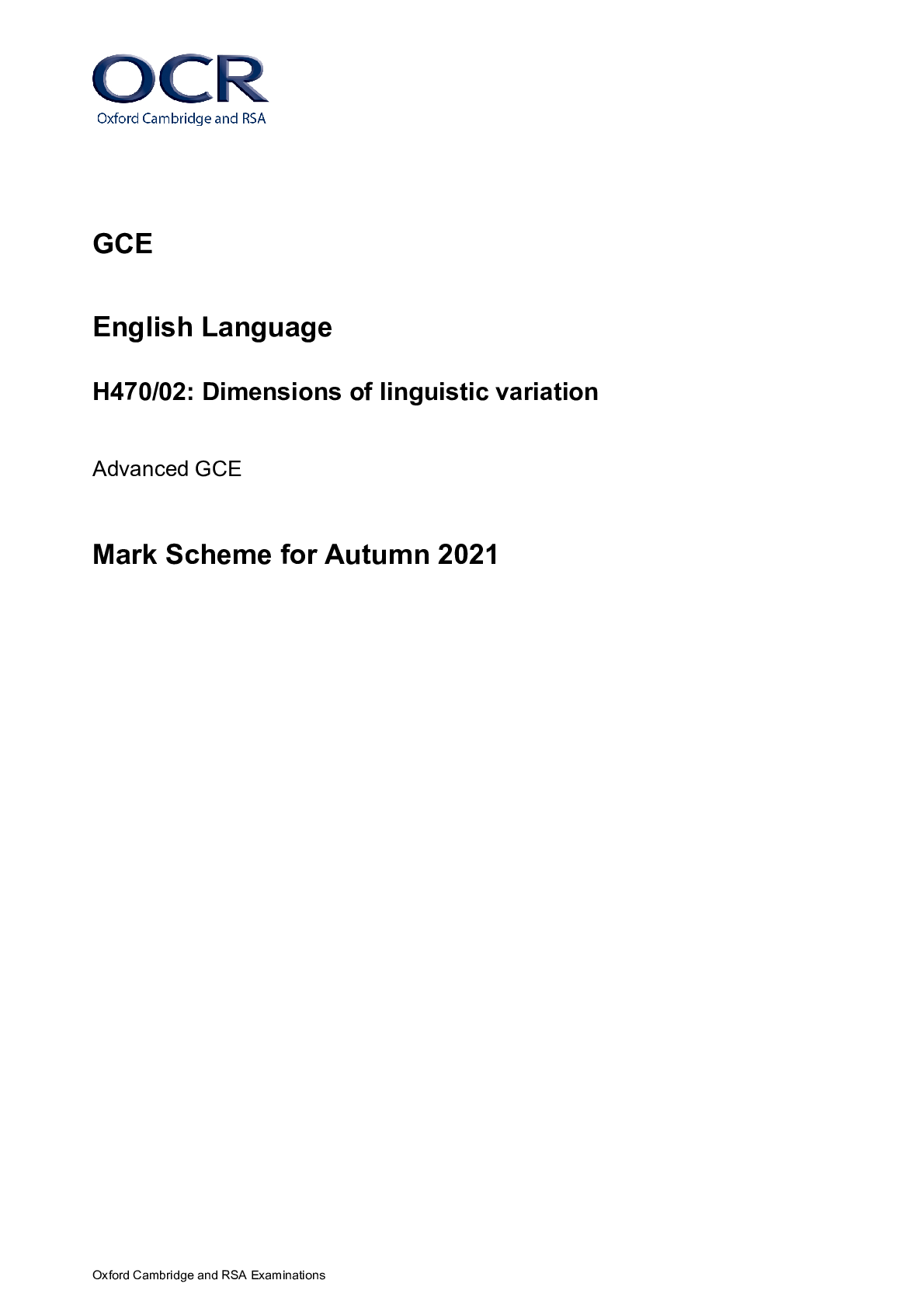
Buy this document to get the full access instantly
Instant Download Access after purchase
Add to cartInstant download
We Accept:

Reviews( 0 )
$7.50
Document information
Connected school, study & course
About the document
Uploaded On
Oct 10, 2022
Number of pages
22
Written in
Additional information
This document has been written for:
Uploaded
Oct 10, 2022
Downloads
0
Views
70

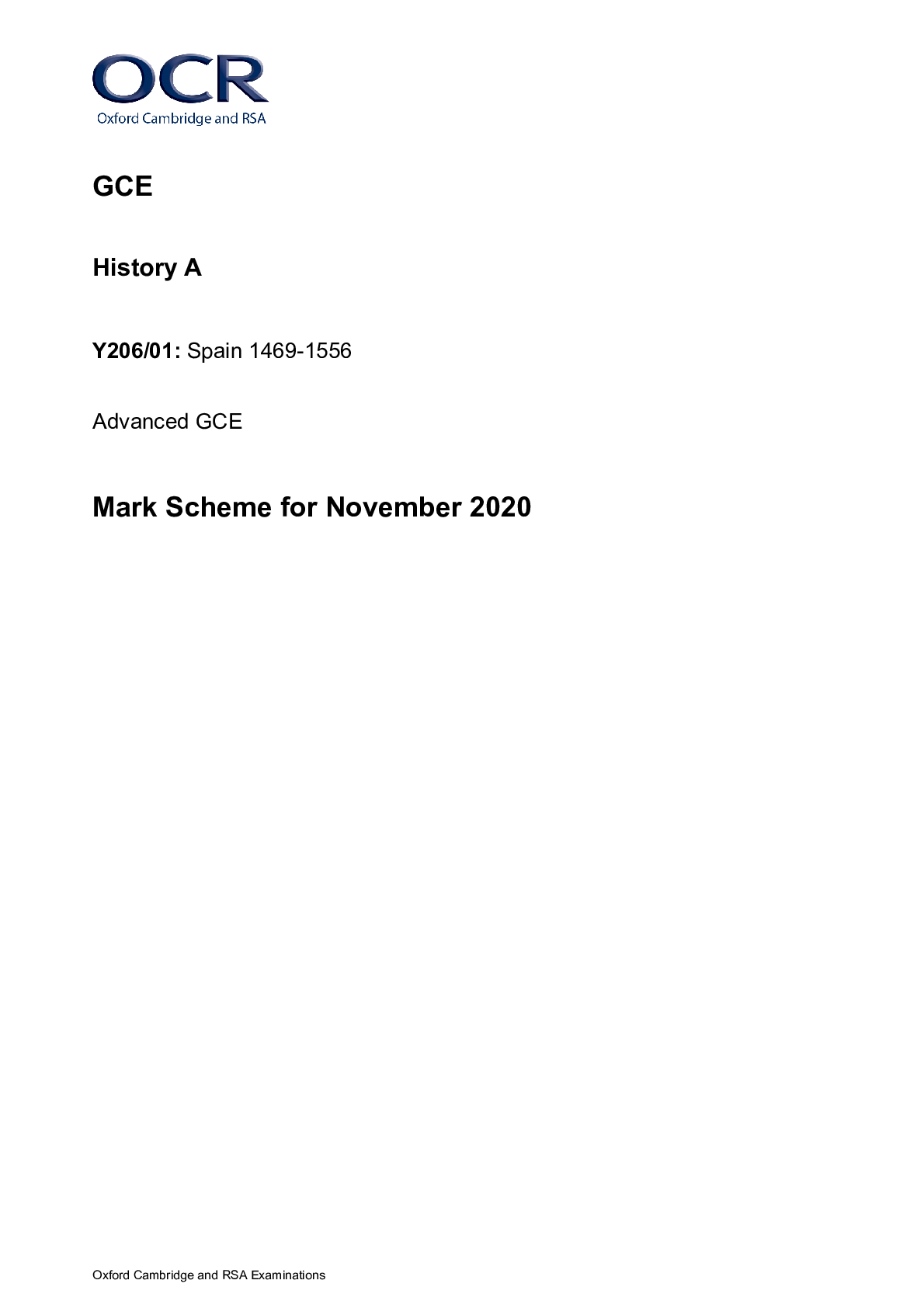
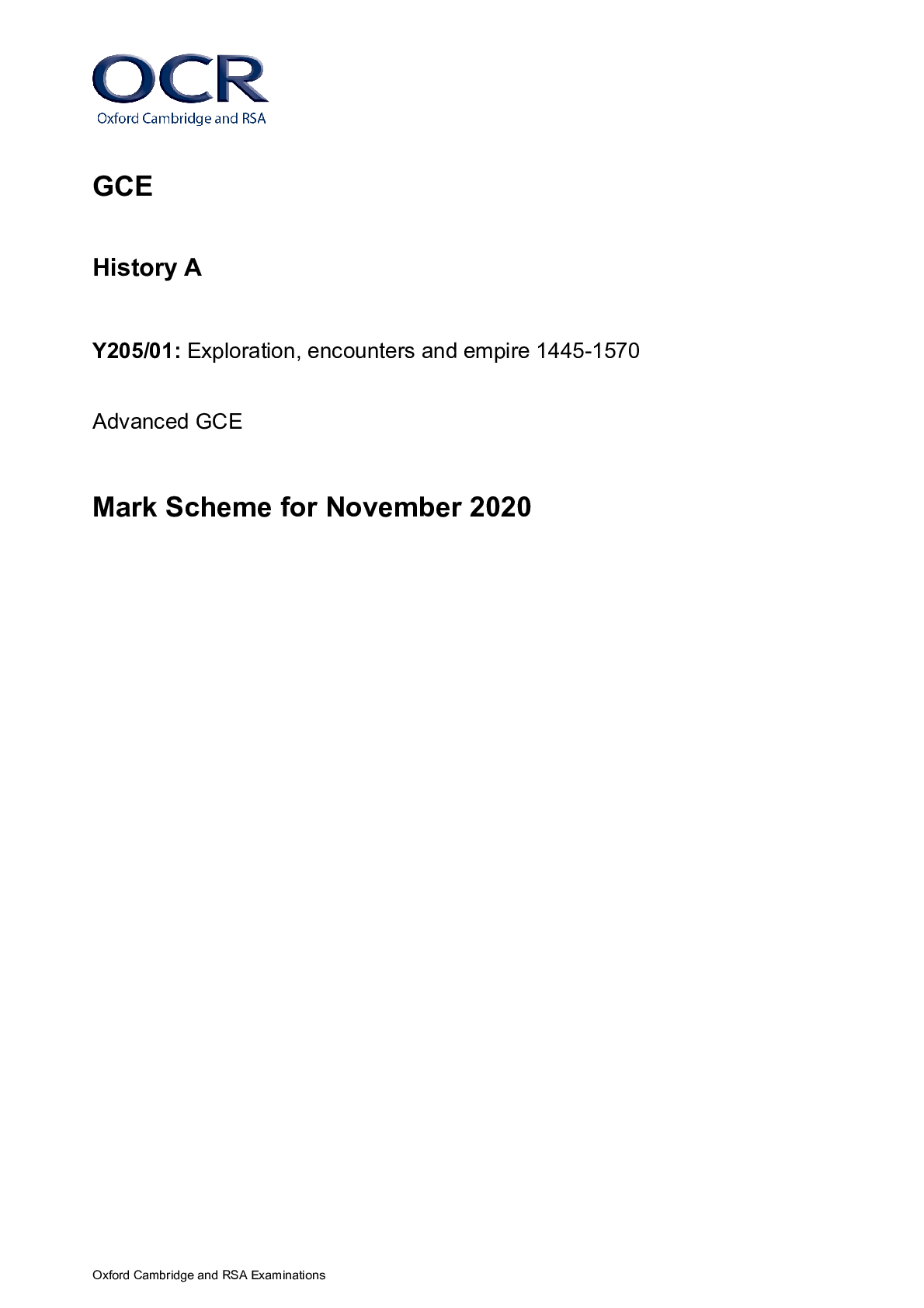






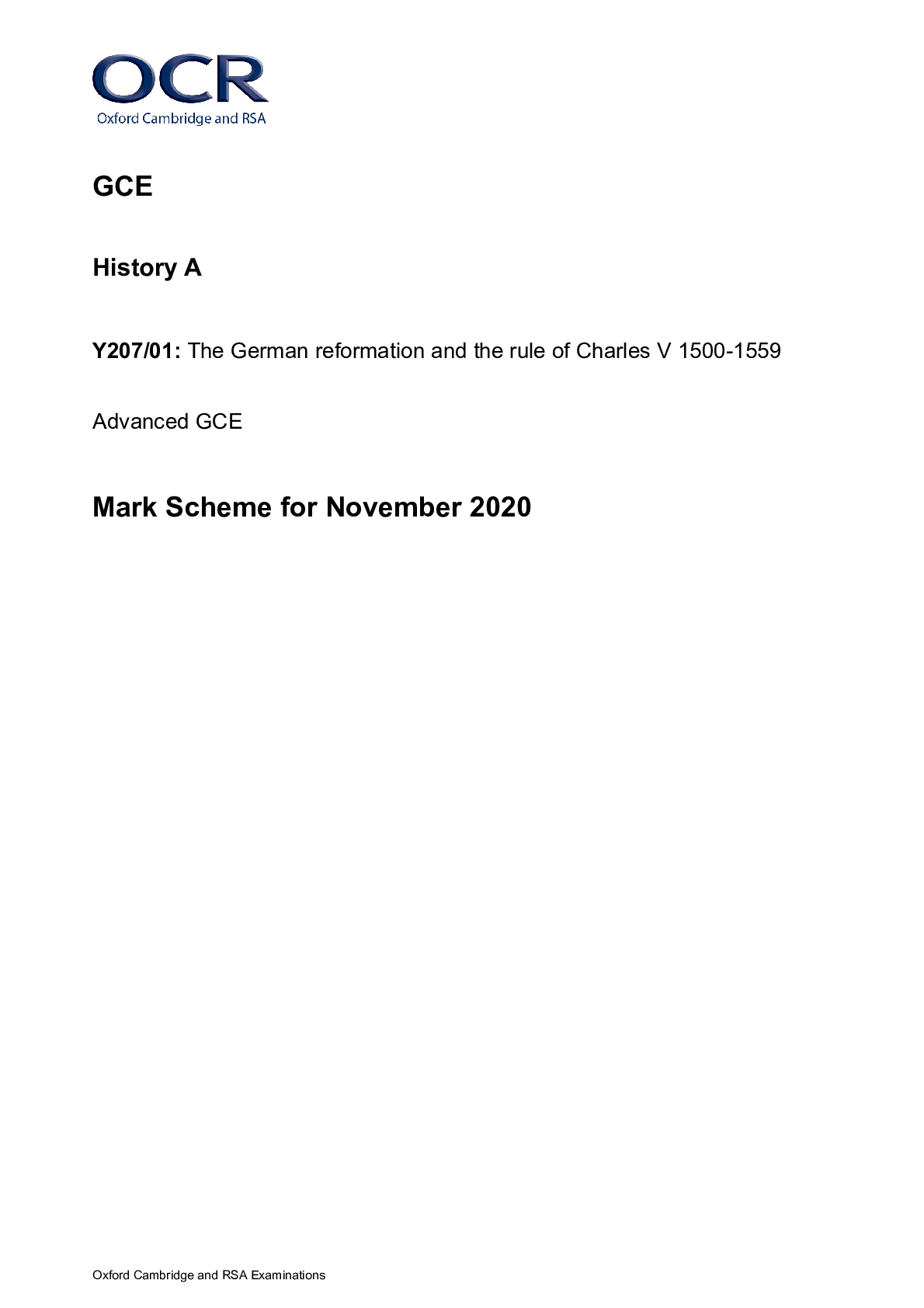






.png)


